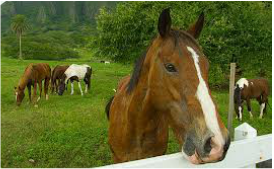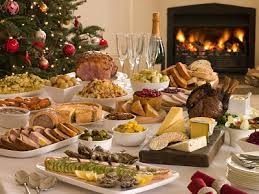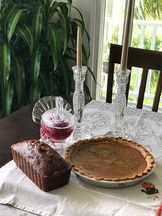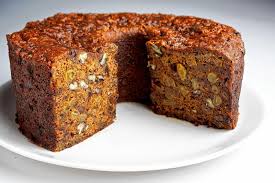|
… he saw three men standing nearby. When he saw them, he ran from the entrance of the tent to greet them; and bowing to the ground, he said: “Sir, if I may ask you this favor, please do not go on past your servant. Let some water be brought, that you may bathe your feet, and then rest yourselves under the tree … let me bring you a little food, that you may refresh yourselves…” Abraham hastened into the tent and told Sarah, “Quick, three seahs of fine flour! Knead it and make rolls.” He ran to the herd, picked out a tender, choice steer, and gave it to a servant, who quickly prepared it. Then he got some curds and milk as well as the steer that had been prepared, and set these before them; and he waited on them under the tree while they ate. |
On Christmas night, the
Full moon glows on the horses,
Feeding in the field.
Eventually, I became a pretty good home baker, and I was struck with the idea of hosting a Holiday Dessert Party before Christmas for my family members, friends and even for some of my students. Once this idea took hold, I could not stop myself. I read cooking magazines year-round and saved recipes that seemed to have promise. I started my menu planning in July, writing up lists of possible cakes, pies, puddings, candies and cookies to include. Then I would spend hours picturing how all of the finished desserts would look arranged on the lace table cloth, interspersed with Christmas candles and greenery. I would plan which bowls, platters and dishes to use, making sure to include treasured old plates and bowls I had inherited from my grandmother. I also thought about the various flavors, colors, sizes, shapes, textures and temperatures of the many desserts I wanted to offer and how they would complement each other.
|
A fat brown goose lay at one end of the table and at the other end, on a bed of creased paper strewn with sprigs of parsley, lay a great ham, stripped of its outer skin and peppered over with crust crumbs, a neat paper frill around its shin and beside this was a round of spiced beef. Between these rival ends ran parallel lines of side-dishes: two little ministers of jelly, red and yellow; a shallow dish full of blocks of blancmange and red jam, a large green leaf-shaped dish with a stalk-shaped handle, on which lay bunches of purple raisins and peeled almonds, a companion dish on which lay a solid rectangle of Smyrna figs, a dish of custard topped with grated nutmeg, a small bowl full of chocolates and sweets wrapped in gold and silver papers and a glass vase in which stood some tall celery stalks. In the centre of the table there stood, as sentries to a fruit-stand which upheld a pyramid of oranges and American apples, two squat old-fashioned decanters of cut glass, one containing port and the other dark sherry. On the closed square piano a pudding in a huge yellow dish lay in waiting and behind it were three squads of bottles of stout and ale and minerals, drawn up according to the colours of their uniforms, the first two black, with brown and red labels, the third and smallest squad white, with transverse green sashes. |
Aunt Rose’s Holiday Dessert Party
Traditional Fruitcakes
Old English Fruitcake with Hard Sauce (An American Southern Tea)
Panforte (An Italian Tea)
Pound Cakes
Ellen’s Fabulous Coconut Cake (An American Southern Tea)
Orange Poppy Seed Cake
Chocolate Cakes
Queen of California Cake (A California Tea)
Chocolate Biscuit Cake (A Classic British Afternoon Tea)
Caramel Cakes
Caramel Toffee Yule Log (A Christmas Tea)
Sticky Date Pudding with Caramel Sauce (A Tea for Our Elders)
Yeast Bread and Pastry
German Christmas Stollen
Danish Christmas Wreath (A Christmas Tea)
Pies
Lemon Chess Pie (August Family Reunion Tea)
Chocolate Almond Fudge Pie
Chilled Molded Desserts
Spiced Apple Gelatin (North American Family Reunion Tea)
Chestnut Bavarian with Chocolate Sauce (A Winter Afternoon Tea)
Cheesecakes
Pumpkin Sherry Cheesecake
Chocolate Mocha Cheesecake
Chilled Puddings
Christmas Trifle (A Christmas Tea)
Tiramisu
Rustic Puddings
Warm Bread Pudding with Lemon Sauce (Afternoon Tea for a Large Group)
Afghan Rice Pudding
Steamed Puddings
Steamed Pumpkin Pudding with Candied Cranberries (A Christmas Tea)
Steamed Gingerbread
Quick Breads
Lemon Tea Cake (Tea Menu Basics)
Persimmon Bread (Tea Menu Basics)
International Pastries
Baklava (A Greek or Middle Eastern Family Reunion Tea)
Madeleines (A French Afternoon Tea)
Christmas Cookies
Spritz Cookies (A Christmas Tea)
Orange Ginger Cookies (A Christmas Tea)
Shortbread Cookies (A Classic British Afternoon Tea)
Almond Butter Cookies (A California Tea)
Mexican Wedding Cookies (A Tea to Honor Our Ancestors)
Mexican Chocolate Cookies with Chili (A Tea to Honor Our Ancestors)
Chocolate Chip Cookies (A Tea for Our Elders)
For the Cake:
- 1 pound golden raisins (3 cups)
- 4 ½ cups (1 pound) chopped toasted almonds
- 3 cups flour
- ½ teaspoon salt
- 2 cups (4 sticks) unsalted butter, at room temperature
- 2 cups sugar
- grated rind of 1 lemon
- 6 large eggs, separated and at room temperature
- 1 teaspoon baking soda
- 1 tablespoon warm water
- 1 (one-ounce) bottle pure lemon extract
- cooking spray containing flour
- For the Lemon-Rum glaze
- 2 cups sugar
- ½ cup light corn syrup
- ¾ cup water
- juice of 1 lemon
- 1 cup rum (or orange flavored liqueur)
Preheat oven to 250° F
Special equipment: large mixing bowl, medium sized mixing bowl, small mixing bowl, small bowl, sieve or flour sifter, electric mixer, rubber spatula, aluminum foil, cookie sheet, citrus zester, citrus juicer, 2 (9” x 5” x 3”) loaf pans, parchment paper, thin knife, wooden skewer, 2-3-quart saucepan with lid, wire rack, plastic wrap
Makes: 2 large loaf cakes or 1 Bundt cake and 1 smaller loaf
- Toast the chopped almonds in a 350°F oven on a foil lined baking sheet for 10 minutes, until lightly browned, stirring twice to prevent burning. Set aside to cool, and lower the oven temperature to 250° F.
- Grate the zest from the lemon onto a paper towel and set aside. Squeeze the juice from the lemon and set it aside to use in the glaze. Spray the loaf pans with cooking spray and line with parchment paper. Spray the parchment and set the pans aside. Combine the raisins, lemon zest and nuts in a medium sized mixing bowl and toss with 1 cup of flour until well coated. Set aside.
- In a small mixing bowl, sift together the remaining 2 cups of flour with ½ teaspoon of salt. Set aside. In a large mixing bowl with an electric mixer, beat the butter until light and fluffy. Add the sugar and beat again until very light and fluffy, about 4 minutes. Add the egg yolks and beat until well incorporated.
- Add the flour and salt mixture at low speed, and beat until just combined. In a small bowl, stir the baking soda into 1 tablespoon of warm water until dissolved. Add the baking soda mixture and the lemon extract to the butter mixture and beat on low speed just until incorporated.
- Using a rubber spatula, stir in the raisin and nut mixture, including the flour remaining in the bowl, until none of the flour is still visible. Clean and dry the beaters, and beat the egg whites in a clean medium sized bowl until stiff peaks form. Gently fold the egg whites into the batter until the mixture is well combined. (It will be lumpy.)
- Divide the batter between the two prepared loaf pans and smooth the tops with a rubber spatula. Gently tap the bottoms of the pans against the counter to release any bubbles. Bake until the tops of the cakes are golden and a thin knife inserted into the center of each cake comes out clean, about 2 ¾ hours. When the cakes have almost finished baking, make the glaze.
- Combine all of the glaze ingredients except the rum in a 2-3-quart saucepan. Stir slowly over medium high heat until the mixture boils. Cover and boil until the mixture is clear and the sugar has dissolved, about 1 minute. Remove the glaze from the heat, uncover and let the mixture stand for 5 minutes. Stir in the rum.
- Cool the cakes on a wire rack for 10 minutes; carefully remove the cakes from the pans, and remove the parchment. Replace the cakes into the pans, and poke holes into the cakes with a thin wooden skewer. Carefully pour the warm glaze over both cakes and allow them to continue cooling on the wire rack.
- When the cakes are completely cool, wrap them in plastic wrap and then in foil, and store them in an airtight container at room temperature for up to two weeks or freeze them for one month. This cake is best when aged for at least one day to allow the flavors to develop.








